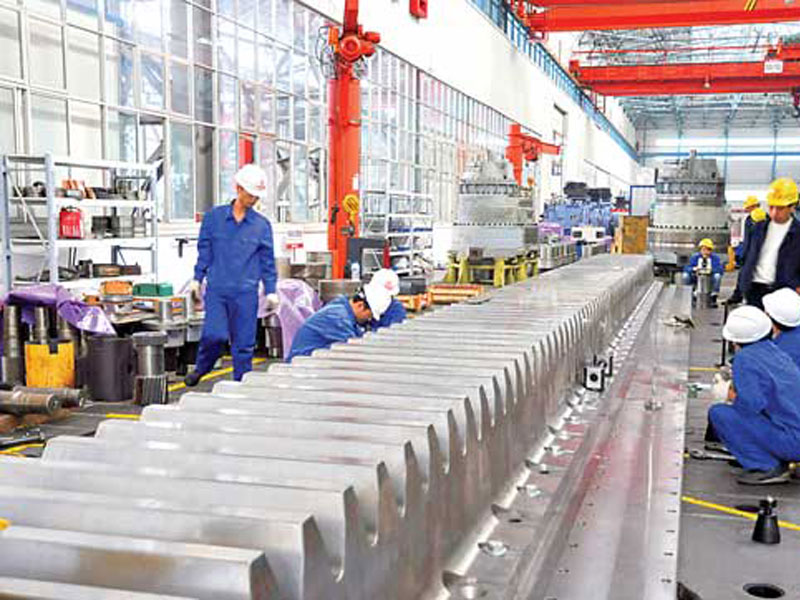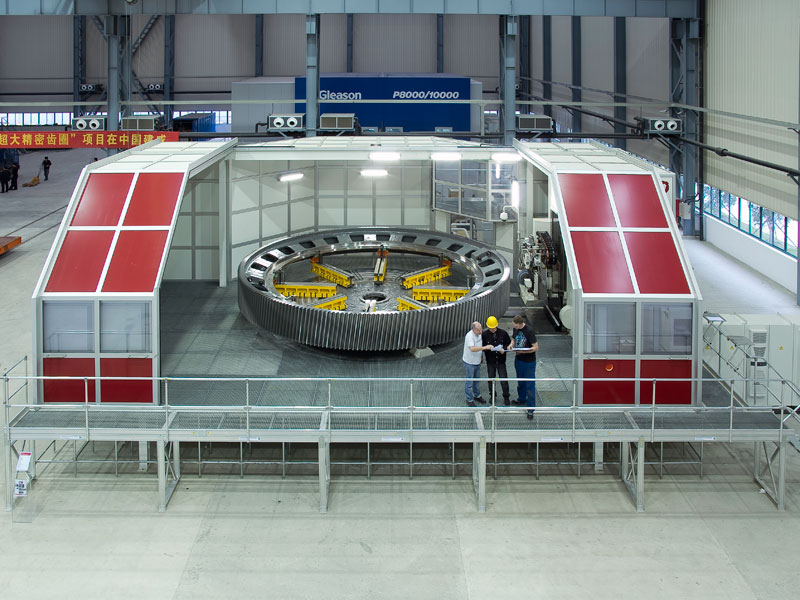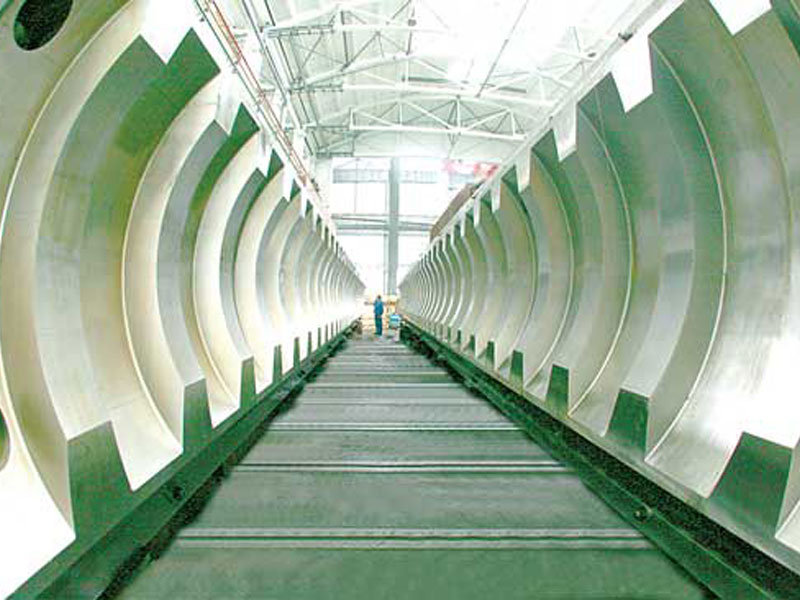Full Annealing
Full annealing consists of heating steel or other ferrous alloys to 1475-1650_F (802-899_C) and furnace cooling to a prescribed temperature, generally below 600_F (316_C). This treatment forms coarse lamellar pearlite, the best microstructure for machinability of low andmedium carbon steels. Unless otherwise stated, annealing is assumed to mean full annealing.
Spheroidizing Annealing
Spheroidize annealing is a process of heating and cooling steel that produces a globular carbide in a ferritic matrix. This heat treatment results in the best machinability for high carbon (0.60 percent carbon or higher) and alloy steels.
Austempering
Austempering is a heat treat process consisting of quenching a ferrous alloy (steel or ductile iron) from a temperature above the transformation range in amediumhaving a rate of cooling sufficiently high to prevent high temperature transformation products, and maintaining the alloy temperature within the bainitic range until desired transformation is obtained. The bainitic transformation range is below the pearlitic range, but above themartensitic range. Austempering is applied to steels and, more recently in the development stage for ductile iron gearing.
Austenite
Austenite in ferrous alloys is amicrostructural phase consisting of a solid solution of carbon and alloying elements in face-centered cubic crystal structured iron.
Austenitizing Temperature
The temperature at which ferrous alloys undergo a completemicrostructural phase transformation to austenite.
Bainite
Bainite is a microstructural phase resulting from the transformation of austenite, and consists of an aggregate of ferrite and iron carbide. Its appearance is feathery if formed in the upper portion of the bainite transformation range, and acicular if formed in the lower portion.
Carbon
Carbon is the principal hardening element in steel, and it’s amount determines the maximumhardness obtainable.Generally as carbon is increased, tensile strength and wear resistance increase; however, ductility and weldability decrease.
Carbonitriding
A modified form of gas carburizing, in which steel (typically plain carbon and very low alloy) is heated between 1450-1650_F(788-899_C) in an ammonia enriched carburizing atmosphere. This results in simultaneous absorption of carbon and nitrogen, which results in the formation of complex nitrides in a high carbon case.
Gas Carburizing
Gas carburizing consists of heating and holding low carbon or alloy steel (less than 0.30 percent carbon) at 1650-1800_F (899-982_C) in a controlled carbonaceous atmosphere, which results in the diffusion of carbon into the part (0.70-1.00 percent carbon is typically obtained at the surface). Temperatures above 1800_F (982_C) may be ultilized in specialized equipment such as vacuum carburizers. After carburizing, parts are either cooled to 1475-1550_F (802-843_C) and held at this temperature to stabilize and then direct quenched; or slow cooled and reheated to 1475-1550_F (802-843_C) and quenched.
Case Depth of Carburized Components
The case depth for carburized gearing may be defined in several ways including effective case depth, etched case depth, total case depth, and depth to 0.40 percent carbon.
Effective case depth
The effective case depth is the hardened depth to HRC 50 at 0.5 tooth height and mid face width, normal to the tooth surface.
Etched case depth
Etched case depth is determined by etching a sample cross-section with nitric acid, and measuring the depth of the darkened area. The etched case approximates the effective case. Hardness survey is preferred for contral purposes.
Total case depth
The total case depth is the depth to which the carbon level of the case has decreased to the carbon level of the base material. This is approximately 1.5 times the effective case depth.
Case depth to 0.40 percent carbon
Effective case depth is less frequently referred to as the depth to 0.40 percent carbon. This depthmay bemeasured by analyzing the carbon content or estimating based on microstructure. Estimating based on microstructure ignores the hardenability of the base material and is not as accurate ameasurement as directly analyzing the carbon level. There is poor correlation betweenmicrostructure readings andmaterial strength gradients using this method.
Case Depth of Flame or Induction Harden Components
This is defined as the depth at which the hardness is 10HRC points belowtheminimumspecified surface hardness.
Case Depth of Nitrided Components
Nitrided case depth is defined as the depth at which the hardness is equivalent to 105 percent of the measured core hardness. The case depth is determined by amicrohardness tester andmeasured normal to the tooth surface at 0.5 tooth height andmid face width.
Case Hardness
Case Hardness is the micro- hardness measured perpendicular to the tooth surface at a depth of 0.002 to 0.004 inches (0.05 to 0.10 mm) at 0.5 tooth height and mid face width.
Cementite
Cementite is a hard microstructure phase otherwise known as iron carbide (Fe3C) and characterized by an orthorhombic crystal structure.
Combined Carbon
The amount of carbon in steel or cast iron that is present in other than elemental form.
Core Hardness
Core Hardness for tooth design purposes is the hardness at the intersection of the root diameter and the centerline of the tooth atmid face width on a finished gear.
D.I. (Ideal Critical Diameter)
Ideal critical diameter is the diameter which, when quenched in an infinite quench severity (such as ice brine), will result in a microstructure consisting of 50 percent martensiteof the center of the bar.
Decarburization
Decarburization is the reduction in surface carbon content of a gear or test piece during thermal processing.
Ferrite (alpha)
Ferrite is a microstructural phase consisting of essentially pure iron, and is characterized with a body centered cubic structure.
Flame Hardening
Flame Hardening of steel gearing involves oxyfuel burner heating to 1450-1650_F (788-899_C) followed by quenching and tempering.
Grain Size. Grain size is specified as either coarse (grain size 1 through 4) or fine (grain size 5 through 8), determined according to ASTM E112.
Graphite
Graphite is carbon in the free state with a shape described as either flake, nodule, or spheroid. The graphite shape classifies the type of cast iron as either gray, ductile, or malleable.
Hardenability
An indication of the depth to which a steel will harden during heat treatment.
Hardening
The process of increasing hardness, typically through heating and cooling.
H-Band Steels
H-Band steels are steels which are produced and purchased to a specified Jominy hardenability range.
Induction Hardening
Induction hardening of gearing is the selective heating of gear teeth profiles to 1450-1650_F (788-899_C) by electrical inductance through the use of a coil or single tooth inductor to obtain the proper heat pattern and temperature, followed by quenching and tempering.
Jominy End Quenching Hardenability Test
The standard method for determining the hardenability of steel.The test consists of heating a standard one inch (25 mm) diameter test bar to a specified temperature, placing the specimen in a fixture so that a stream of water impinges on one end, cooling the specimen to room temperature, grinding flats, and measuring the hardness at 1/16 inch (1.6mm) intervals starting at the quenched end.
Martensite
Martensite is the diffussionless transformation of austenite to a body centered tetragonal structure, characterized by an acicular needle-like appearance.
Microstructure
Microstructure is the material structure observed on a sample polished to a mirror finish, etched, and viewed at 100X or highermagnification.
Nitriding (Aerated Salt Bath)
This term includes a number of heat treat processes in which nitrogen and carbon in varying concentrations are absorbed into the surface of a ferrousmaterial at a temperature below the austenitizing temperature [1000-1150_F (538-621_C)], while submerged in a gas stirred and activated molten chemical salt bath. These processes are used mainly for improved wear resistance and fatigue strength.
Nitriding (Gas)
Surface hardening process in which alloy steel, after machining following quench and tempering, is subjected to a cracked ammonia furnace atmosphere at 950-1060_F (510-571_C) causing nitrogen to be absorbed into the surface, forming hard iron nitrides.
Nitrocarburizing
Nitrocarburizing is a gaseous heat treatment in which both nitrogen and carbon are absorbed into the surface of a ferrousmaterial at a temperature below the austenitizing temperature [1000-1150_F (538-621_C)]. Nitrocarburizing is done mainly for antiscuffing and to improve surface fatigue properties.
Normalizing
Normalizing consists of heating steel or other ferrous alloys to 1600-1800_F (871-982_C) and cooling in still or circulated air. Normalizing is used primarily to obtain a uniformmicrostructure.
Pearlite
Pearlite is a microstructure consisting of lamellar layers of ferrite and cementite, with a body centered cubic crystal structure.
Quench and Temper
The quench and temper process on ferrous alloys involves heating a part to the austenite transformation state at 1475-1650_F (802-899_C), followed by rapid cooling (quenching). The part is then reheated (tempered) to a specific temperature generally below1275_F (690_C) to achieve the desired mechanical properties for the gear application.
Stress Relief
Stress relief is a thermal cycle used to relieve residual stresses created by prior heat treatments, machining, cold working, welding, or other fabricating techniques. Maximum stress relief is achieved at 1100_F (593_C) minimum.
Surface Hardness
Surface Hardness is the hardnessmeasured directly on the surface. To obtain accurate results on shallowcase hardened parts, a superficial test must be used.
Tempering
Tempering is reheating a hardened part to a specified temperature, generally below 1275_F (690_C) to reduce hardness and increase toughness.
Test Coupon
A test coupon is an appropriately sized sample(often a bar) used generally for surface hardening treatments. It should be of the same specified material grade, with regard to composition and hardenability limits, as the gear it represents. The test coupon should be heat treated along with thegear(s) it represents.
Through Hardening
Through hardening is a term used to collectively describe methods of heat treatment of steel other than surface hardening techniques. These include: annealing, normalizing (or normalizing and tempering) and quenching and tempering. Depth of hardening is dependent upon hardenability, section size and heat treat considerations. Through hardening does not imply that the part has equivalent hardness throughout the entire cross section. Transformation Temperature. The temperature at which a change in microstructure phase occurs.






